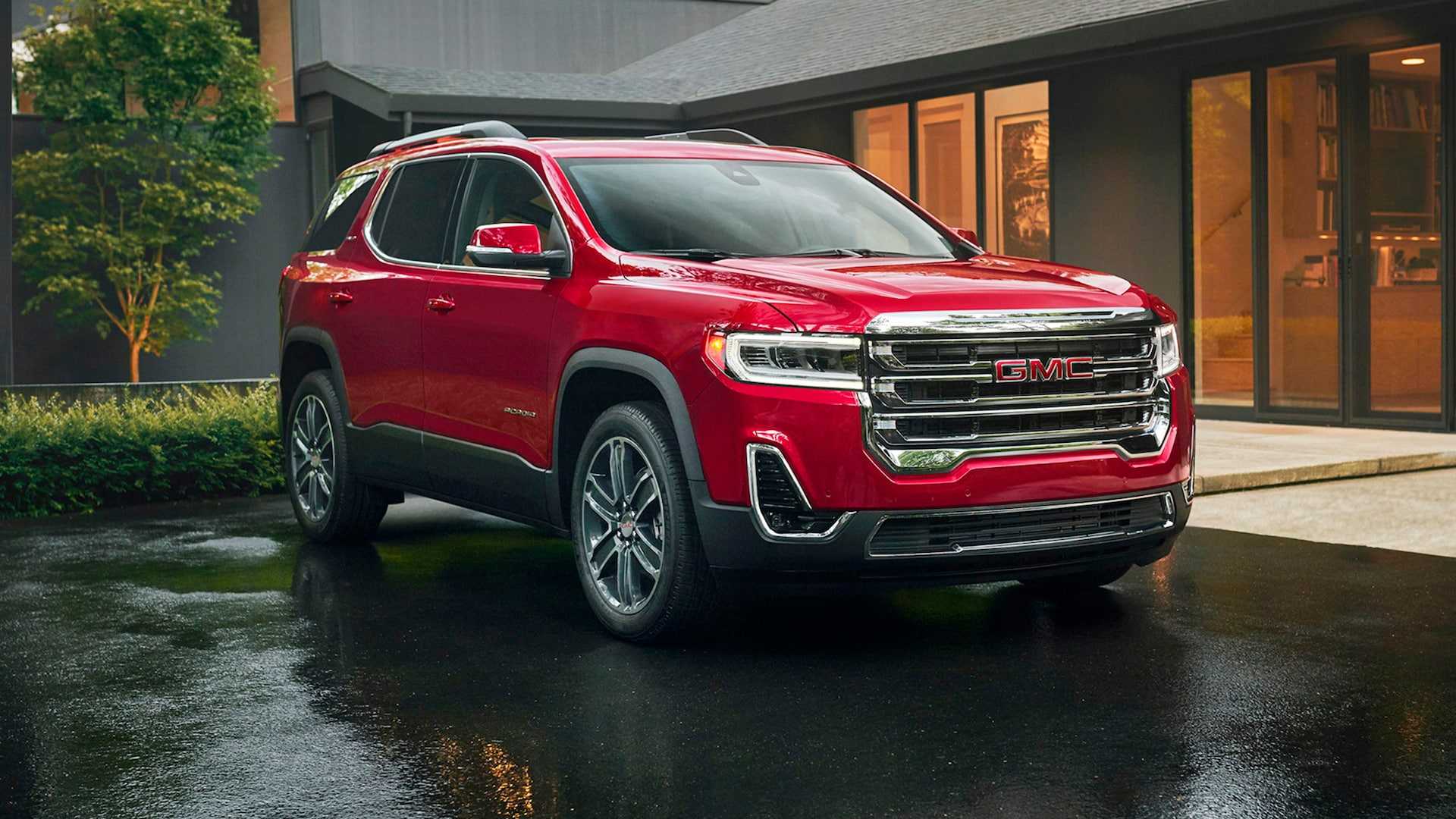GMC Acadia 2023 Starting and Operating
The starting and operating processes for the 2023 GMC Acadia are made to be smooth and reliable for drivers. The Acadia usually comes with a keyless ignition system, so all you have to do to start it is press the brake pedal and press the ignition button. The engine of the car, whether it’s a gasoline or hybrid powertrain, is designed to run smoothly and efficiently, and the transmission has quick gear shifts. The Acadia makes sure that every trip starts and ends smoothly, whether you’re working in the city or going on an adventure. It has features like start/stop technology that saves fuel and available all-wheel drive systems that improve traction.
2023 GMC ACADIA Specs, Price, Features and Mileage (Brochure)
Starting and Operating
New Vehicle Break-In
Caution
The vehicle does not need an elaborate break-in. But it will perform better in the long run if you follow these guidelines:
- Do not drive at any one constant speed, fast or slow, for the first 800 km (500 mi). Do not make full-throttle starts. Avoid downshifting to brake or slow the vehicle.
- Avoid making hard stops for the first 300 km (200 mi) or so. During this time the new brake linings are not yet broken in. Hard stops with new linings can mean premature wear and earlier replacement.
- Follow this breaking-in guideline every time you get new brake linings.
- Do not tow a trailer during break-in.
Following break-in, engine speed and load can be gradually increased. On new vehicles, the various mechanical and electrical systems experience a “break-in” period during the first 6 400 km (4,000 mi) of routine driving. As the vehicle is driven, the mechanical systems adjust to provide optimal fuel economy and transmission shift performance. Electrical systems will adapt and calibrate during the break-in period. A one-time occurrence of clicks and similar vehicle noises is normal during this process. Normal driving charges the vehicle’s battery to achieve the best operation of the vehicle, including fuel economy and the Stop/Start System.
Ignition Positions
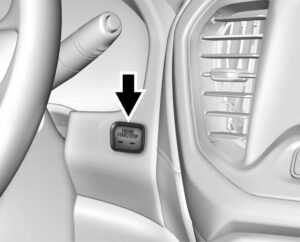
The vehicle has an electronic keyless ignition with a pushbutton start. The remote key must be in the vehicle for the system to operate. If the pushbutton start is not working, the vehicle may be near a strong radio antenna signal causing interference to the remote key system. To shift out of P (Park), the vehicle must be on and the brake pedal must be applied.
Stopping the Engine/LOCK/OFF (No Indicator Lights) : When the vehicle is stopped, press ENGINE START/STOP once to turn the engine off. If the vehicle is in P (Park), the ignition will turn off, and Retained Accessory Power (RAP) will remain active. If the vehicle is in R (Reverse), D (Drive), or L (Low), the vehicle will shift to P (Park), the ignition will turn off, and Retained Accessory Power (RAP) will remain active. If the vehicle is in N (Neutral), the ignition will return to accessory mode and display the message SHIFT TO PARK in the Driver Information Center (DIC). When the vehicle is shifted into P (Park), the ignition will turn off. Do not turn the engine off when the vehicle is moving. This will cause a loss of power assist in the brake and steering systems and disable the airbags.
If the vehicle must be shut off in an emergency:
- Brake using a firm and steady pressure. Do not pump the brakes This may deplete power assist, requiring increased brake pedal force.
- Shift the vehicle to N (Neutral). This can be done while the vehicle is moving. After shifting to N (Neutral), firmly apply the brakes and steer the vehicle to a safe location.
- Come to a complete stop and shift to P (Park).
- Set the parking brake. See Electric Parking Brake 0 216. And press ENGINE START/STOP to turn the vehicle off.
Warning
Turning off the vehicle while moving may cause loss of power assist in the brake and steering systems and disable the airbags. While driving, only shut the vehicle off in an emergency. If the vehicle cannot be pulled over and must be shut off while driving, press and hold ENGINE START/STOP for longer than two seconds, or press twice in five seconds.
Accessory Mode (Amber Indicator Light): This mode allows some electrical accessories to be used when the engine is off. With the ignition off, pressing the button one time without the brake pedal applied will place the ignition system in accessory mode. The ignition will switch from accessory mode to off after five minutes to prevent battery rundown. ON/RUN/START (Green Indicator Light) : This mode is for driving and starting. With the ignition off, and the brake pedal applied, pressing the button once will place the ignition system in ON/RUN/START. Once engine cranking begins, release the button. Engine cranking will continue until the engine starts. The ignition will then remain in ON/RUN.
Service Mode
This power mode is available for service and diagnostics, and to verify the proper operation of the malfunction indicator lamp as may be required for emission inspection purposes. With the vehicle off, and the brake pedal not applied, pressing and holding the button for more than five seconds will place the vehicle in Service Mode. The instruments and audio systems will operate as they do in ON/RUN, but the vehicle will not be able to be driven. The engine will not start in Service Mode. Press the button again to turn the vehicle off.
Starting the Engine
Shift the vehicle into P (Park) or N (Neutral). To restart the engine when the vehicle is already moving, use N (Neutral) only.
Caution
Do not try to shift to P (Park) if the vehicle is moving. If you do, you could damage the transmission. Shift to P (Park) only when the vehicle is stopped.
Caution
If you add electrical parts or accessories, you could change the way the engine operates. Any resulting damage would not be covered by the vehicle warranty.
Starting Procedure
- With the Keyless Access system, the remote key must be in the vehicle. Press ENGINE START/STOP with the brake pedal applied. When the engine begins cranking, let go of the button.
- The idle speed will go down as the engine gets warm. Do not race the engine immediately after starting it. If the remote key is not in the vehicle, if there is interference, or if the remote key battery is low, the
- Driver Information Center (DIC) will display a message.
Caution
Cranking the engine for long periods of time, by trying to start the engine immediately after cranking has ended, can overheat and damage the cranking motor, and drain the battery. Wait at least 15 seconds between each try, to let the cranking motor cool down. - If the engine does not start after five to 10 seconds, especially in very cold weather (below −18 °C or 0 °F), it could be flooded with too much gasoline. Try pushing the accelerator pedal all the way to the floor and holding it there as you press ENGINE START/STOP, for up to a maximum of 15 seconds. Wait at least 15 seconds between each try, to allow the cranking motor to cool down. When the engine starts, let go of the button 10 seconds, especially in very cold weather (below −18 °C or 0 °F), it could be flooded with too much gasoline. Try pushing the accelerator pedal all the way to the floor and holding it there as you press ENGINE START/STOP, for up to a maximum of 15 seconds. Wait at least 15 seconds between each try, to allow the cranking motor to cool down. When the engine starts, let go of the button.
Stop/Start System
The Stop/Start system will shut off the engine to help conserve fuel. It has components designed for the increased number of starts.
Warning
The automatic engine Stop/Start feature causes the engine to shut off while the vehicle is still on. Do not exit the vehicle before shifting to P (Park). The vehicle may restart and move unexpectedly. Always shift to P (Park), and then turn the ignition off before exiting the vehicle.
Auto Engine Stop/Start
When the brakes are applied and the vehicle is at a complete stop, the engine may turn off. When stopped, the tachometer displays AUTO STOP. When the brake pedal is released or the accelerator pedal is pressed, the engine will restart. To maintain vehicle performance, other conditions may cause the engine to automatically restart before the brake pedal is released.
Auto Stops may not occur and/or auto restarts may occur because:
- The climate control settings require the engine to be running to cool or heat the vehicle interior.
- The vehicle battery needs to charge.
- The vehicle battery has recently been disconnected.
- Minimum vehicle speed has not been reached since the last Auto Stop
- The accelerator pedal is pressed.
- The engine or transmission is not at the required operating temperature.
- The outside temperature is not in the required operating range.
- The transmission is shifted out of D (Drive) to any gear other than P (Park).
- Certain driver modes have been selected.
- The vehicle is on a steep hill or grade.
- The driver door has been opened or the driver seat belt has been unbuckled.
- The hood has been opened.
- The Auto Stop has reached the maximum allowed time.
Auto Stop/Start Disable Switch
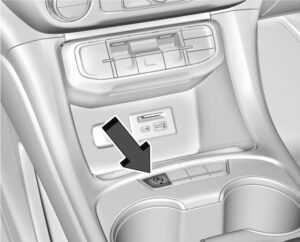
The automatic engine Stop/Start feature can be disabled and enabled by pressing h. Auto Stop/Start is enabled each time you start the vehicle. When the h indicator is illuminated, the system is enabled.
Engine Heater
The engine heater can provide easier starting and better fuel economy during engine warm-up in cold weather conditions at or below −18 °C (0 °F). Vehicles with an engine heater should be plugged in at least four hours before starting. An internal thermostat in the plug-end of the cord may exist, which will prevent engine heater operation at temperatures above −18 °C (0 °F).
Warning
Do not plug in the engine block heater while the vehicle is parked in a garage or under a carport. Property damage or personal injury may result. Always park the vehicle in a clear open area away from buildings or structures.
To Use the Engine Heater
- Turn off the engine.
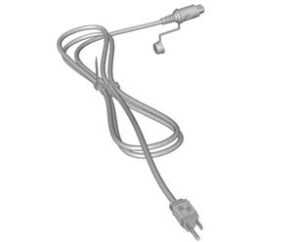
- . Check the heater cord for damage. If it is damaged, do not use it. See your dealer for a replacement. Inspect the cord for damage yearly.
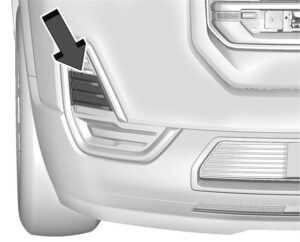
- Remove the engine heater connector cover by gently prying it with a flat blade tool.
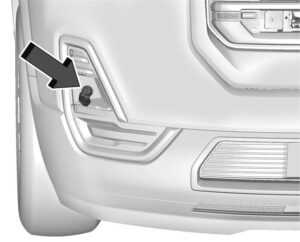
- Plug the heater cord into the connector in the front fascia.
- Plug the cord into a grounded 110-volt AC outlet that is protected by a ground fault detection function.
Warning
Improper use of the heater cord or an extension cord can damage the cord and may result in overheating and fire.- Plug the cord into a three-prong electrical utility receptacle that is protected by a ground fault detection function. An ungrounded outlet could cause an electric shock.
- Use a weatherproof, heavy-duty, 15 amp-rated extension cord if needed. Failure to use the recommended extension cord in good operating condition, or using a damaged heater or extension cord, could make it overheat and cause a fire, property damage, electric shock, and injury.
- Do not operate the vehicle with the heater cord permanently attached to the vehicle. Possible heater cord and thermostat damage could occur.
- While in use, do not let the heater cord touch vehicle parts or sharp edges.
- Before starting the vehicle, unplug the cord. Keep the cord away from any moving parts.
- Before starting the engine, be sure to unplug and store the cord.
- Install the engine heater connector cover.
Retained Accessory Power (RAP)
When the vehicle is turned from on to off, the following features (if equipped) will continue to function for up to 10 minutes, or until the driver door is opened. These features will also work when the vehicle is on or in accessory mode:
- Infotainment System
- Power Windows (during RAP this functionality will be lost when any door is opened)
- Sunroof (during RAP this functionality will be lost when any door is opened)
- Auxiliary Power Outlet
- Audio System
- OnStar System
Shifting Into Park
Warning
It can be dangerous to get out of the vehicle if the vehicle is not in P (Park) with the parking brake set. The vehicle can roll. If you have left the engine running, the vehicle can move suddenly. You or others could be injured. To be sure the vehicle will not move, even when you are on fairly level ground, use the steps that follow. If you are pulling a trailer,
To shift into P (Park):
- Hold the brake pedal down and set the parking brake.
- Press the P (Park) switch on the center console.
- Press ENGINE START/STOP to turn the engine off.
If the vehicle is shifted into P (Park) on a hill, the electric parking brake (EPB) may apply automatically. The driver may not be able to release the EPB using the EPB switch. It should automatically release when the vehicle is shifted out of P (Park).
Leaving the Vehicle with the Engine Running
Warning
It can be dangerous to leave the vehicle with the engine running. It could overheat and catch fire. It is dangerous to get out of the vehicle if the vehicle is not in P (Park) with the parking brake set. The vehicle can roll. Do not leave the vehicle when the engine is running. If you have left the engine running, the vehicle can move suddenly. You or others could be injured. To be sure the vehicle will not move, even when you are on fairly level ground, always set the parking brake and shift the vehicle to P (Park). If you are towing a trailer, If you have to leave the vehicle with the engine running, the vehicle must be in P (Park) with the parking brake set. Confirm that the vehicle is in P (Park).
Torque Lock
Torque lock is when the weight of the vehicle puts too much force on the parking pawl in the transmission. This happens when parking on a hill and shifting the transmission into P (Park) is not done properly and then it is difficult to shift out of P (Park). To prevent torque lock, set the parking brake and then shift into P (Park). To find out how, On certain steep grades, the transmission will automatically set the parking brake to prevent torque lock. If torque lock does occur, the vehicle may need to be pushed uphill by another vehicle to relieve the parking pawl pressure, so you can shift out of P (Park).
Shifting out of Park
This vehicle is equipped with an electronic transmission. If the vehicle has an uncharged battery or a battery with low voltage, try charging or jump-starting the battery.
To shift out of P (Park):
- Ensure the engine is
- Apply the brake
- Press or pull the desired shift switch on the center stack.
The P indicator will turn white and the gear indicator will turn red when the vehicle is no longer in P (Park). If the vehicle cannot shift from P (Park), a Driver Information Center (DIC) message will be displayed. Check that the ignitions on, the engine is running, and the brake pedal is applied when you are attempting to shift out of P (Park). If all of these are met but the vehicle will not shift out of P (Park),
Parking over Things That Burn
Things that can burn could touch hot exhaust parts under the vehicle and ignite. Do not park over papers, leaves, dry grass, or other things that can burn.
Active Fuel Management
This vehicle’s engine may be equipped with Active Fuel Management, which allows the engine to operate on either all of its cylinders or in reduced-cylinder operation mode, depending on the driving conditions. When less power is required, such as cruising at a constant vehicle speed, the system will operate in reduced cylinder operation mode, allowing the vehicle to achieve better fuel economy. When greater power demands are required, such as accelerating from a stop, passing, or merging onto a freeway, the system will maintain full-cylinder operation. If the vehicle has an Active Fuel Management indicator, see the Driver Information Center (DIC) for more information on using this display.
Extended Parking
- It is best not to park with the vehicle running. If the vehicle is left running, be sure it will not move and there is adequate ventilation.
- If the vehicle is left parked and running with the remote key outside the vehicle, it will continue to run for up to 15 minutes.
- If the vehicle is left parked and running with the remote key inside the vehicle, it will continue to run for up to 30 minutes.
- The vehicle could turn off sooner if it is parked on a hill, due to lack of available fuel.
- The timer will reset if the vehicle is taken out of P (Park) while it is running.
FAQ
Starting the Acadia typically involves pressing the brake pedal and pushing the ignition button for vehicles equipped with keyless ignition.
Depending on the model, the Acadia may offer various engine options, including gasoline and hybrid powertrains.
Many models of the Acadia come equipped with keyless entry and ignition, allowing for easy and convenient starting.
Start/stop technology automatically turns off the engine when the vehicle is stationary, such as at a stoplight, and restarts it when you release the brake pedal to improve fuel efficiency.
Depending on the model, the start/stop feature may be able to be disabled through the vehicle settings.
The Acadia typically features an automatic transmission for smooth and efficient gear shifts.
AWD and 4WD systems are often available in the Acadia, enhancing traction and stability, especially in adverse weather conditions.
Hybrid Acadia models may have specific operating instructions related to charging, electric-only driving, and hybrid system management.
Depending on the engine and trim level, the Acadia may be capable of towing trailers, boats, or other loads with varying towing capacities.
The parking brake is typically engaged by pulling up on a lever or pressing a button, and it’s disengaged by releasing the lever or button.
Many models of the Acadia come equipped with hill-start assist, which prevents the vehicle from rolling backward when starting on an incline.
Electronic stability control helps maintain vehicle stability during sudden maneuvers or slippery road conditions, reducing the risk of skidding or loss of control.
Depending on the model, the Acadia may offer different driving modes (e.g., Normal, Sport, Off-Road) to optimize performance and handling.
Some models may offer adjustable steering settings to customize the steering feel to your preference.
It’s often recommended to follow a break-in period for a new engine, which typically involves avoiding aggressive driving during the first few thousand miles.
Useful Link
View Full User Guide: GMC Acadia 2023 User Guide
Download Manuals: https://www.cadillac.com/support/vehicle/manuals-guides
2023 GMC ACADIA Specs, Price, Features and Mileage (Brochure)

